Samsung DV48J7770EP-A2, DV48J7700EW-A2 Product manual
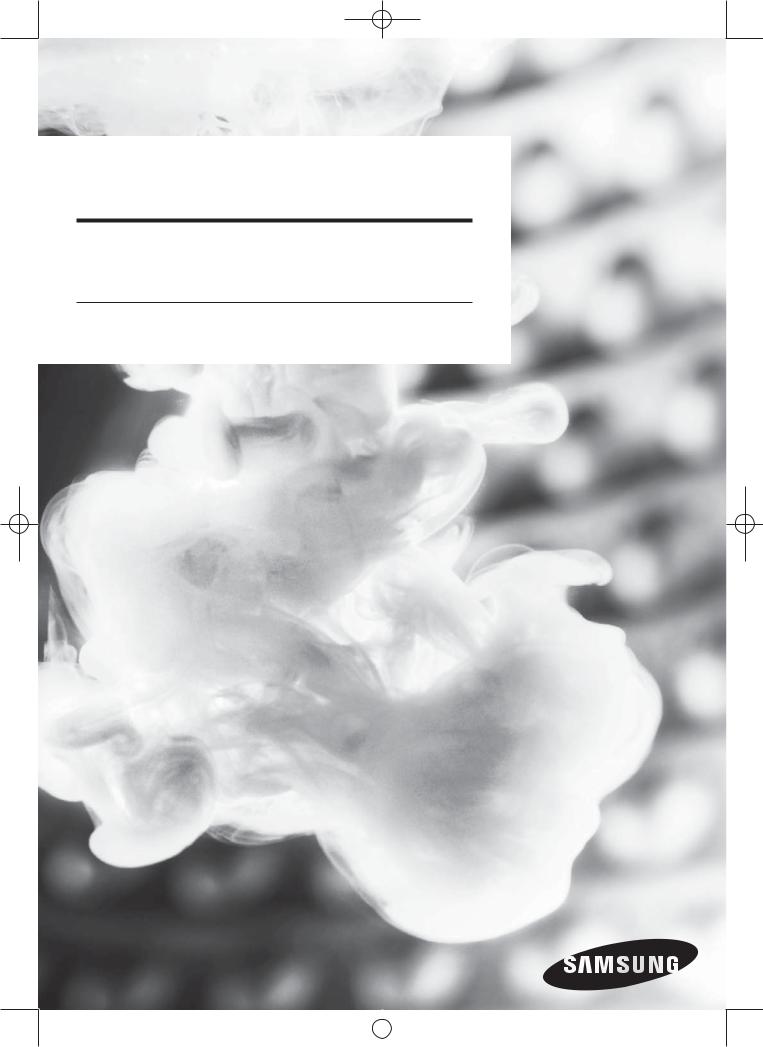
Dryer
User manual
DV48J7700E(G)*/DV48J7770E(G)*
|
|
|
|
DV7700J-03170Q-00_EN-US.indd 1 |
2015/1/31 9:17:41 |
||
|
|
|
|

Contents
Contents
Safety information
What you need to know about the safety instructions Important safety symbols
Important safety precautions
Installation
What’s included
Before installation
Basic requirements
Location considerations
Ducting requirements
Exhausting
Gas requirements
Electrical requirements
Grounding
Electrical connections
Step-by-step installation
Connecting the inlet hose
Final installation check list
Vent blockage test (DV48J7700E(G)*)
Dryer exhaust tips
Door reversal
Before you start
Guideline
Operations
Control panel
Simple steps to start
Cycle overview
Cycle guide
Options
Maintenance
Vent Sensor (DV48J7770E(G)*)
Cleaning
4
4
4
5
10
10
12
12
13
14
16
17
18
19
20
21
26
28
29
30
33
36
36
37
37
40
41
43
44
46
46
47
SAVE THESE INSTRUCTIONS
2 English
|
|
|
|
DV7700J-03170Q-00_EN-US.indd 2 |
2015/1/31 9:17:42 |
||
|
|
|
|
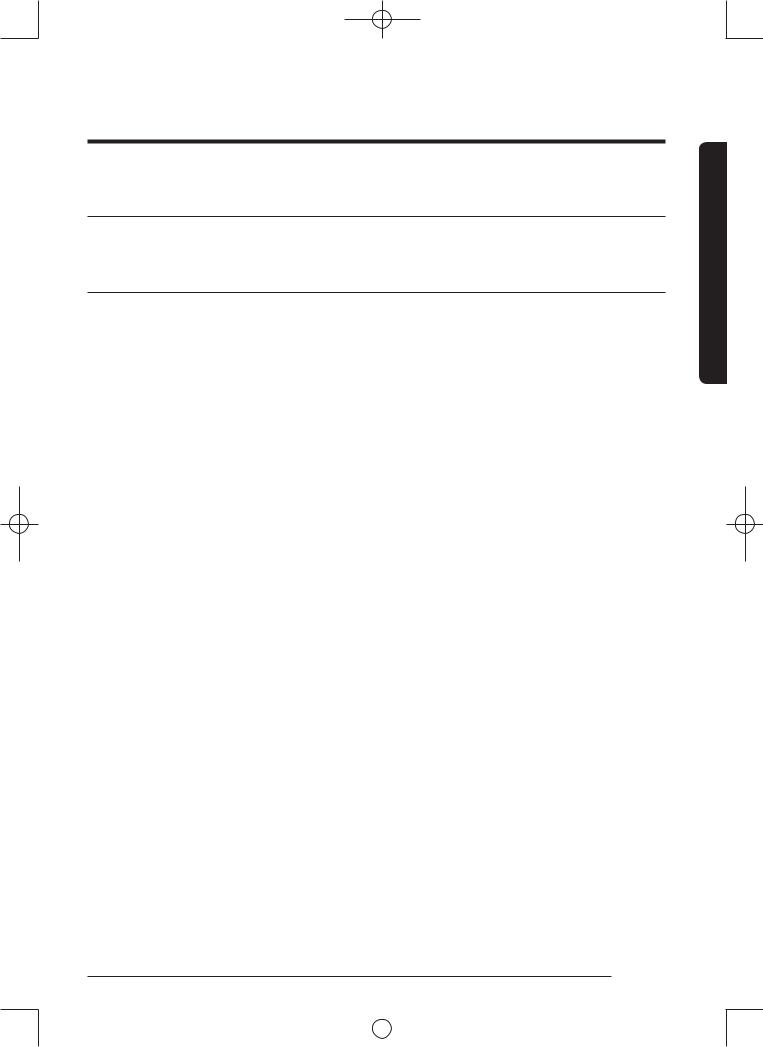
Troubleshooting
Checkpoints
Information codes
Specifications
Protecting the environment Specification sheet
Cycle chart
48
48
51
53
53
54
56
Contents
SAVE THESE INSTRUCTIONS
English 3
|
|
|
|
DV7700J-03170Q-00_EN-US.indd 3 |
2015/1/31 9:17:42 |
||
|
|
|
|
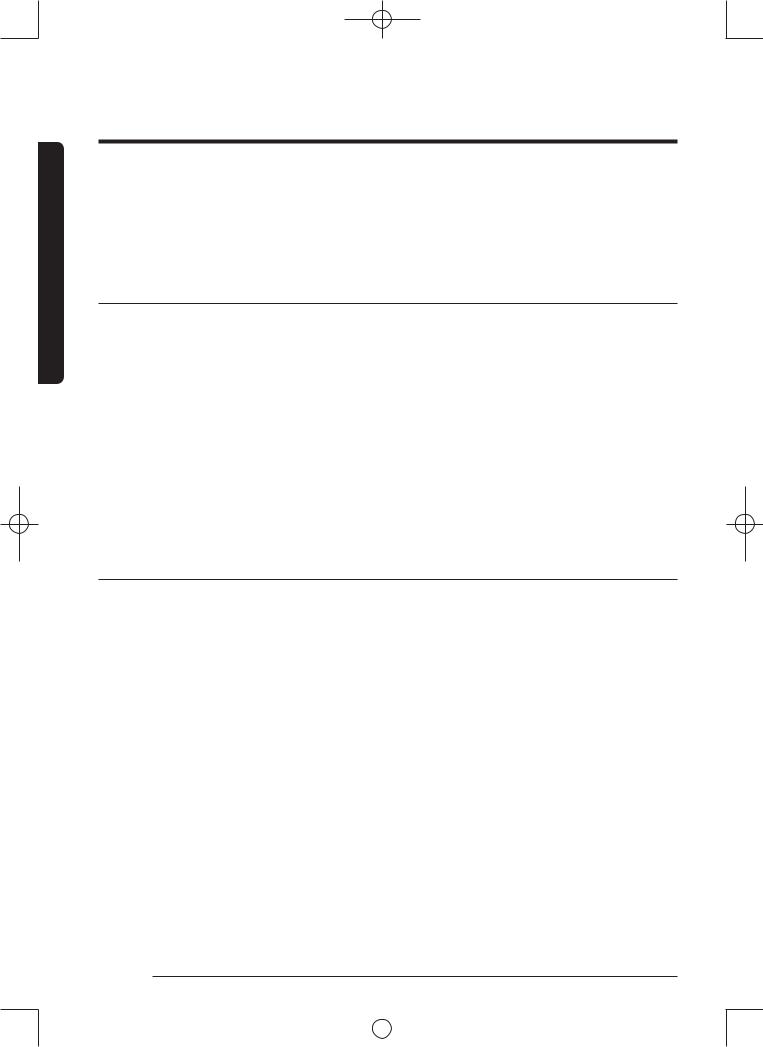
Safety information
Safety information
Congratulations on your new Samsung dryer. This manual contains important information on the installation, use and care of your appliance. Please take some time to read this manual to take full advantage of your dryer’s many benefits and features.
What you need to know about the safety instructions
Please read this manual thoroughly to ensure that you know how to safely and efficiently operate the extensive features and functions of your new appliance. Please store the manual in a safe location close to the appliance for future reference. Use this appliance only for its intended purpose as described in this instruction manual.
Warnings and Important Safety Instructions in this manual do not cover all possible conditions and situations that may occur. It is your responsibility to use common sense, caution and care when installing, maintaining and operating your dryer.
Because the following operating instructions cover various models, the characteristics of your dryer may differ slightly from those described in this manual and not all warning signs may be applicable. If you have any questions or concerns, contact your nearest service center or find help and information online at www.samsung.com.
Important safety symbols
What the icons and signs in this user manual mean:
 WARNING
WARNING
Hazards or unsafe practices that may result in severe personal injury, death and/or property damage.
 CAUTION
CAUTION
Hazards or unsafe practices that may result in personal injury and/or property damage.
 NOTE
NOTE
Indicates that a risk of personal injury or material damage exists.
SAVE THESE INSTRUCTIONS
4 English
|
|
|
|
DV7700J-03170Q-00_EN-US.indd 4 |
2015/1/31 9:17:42 |
||
|
|
|
|
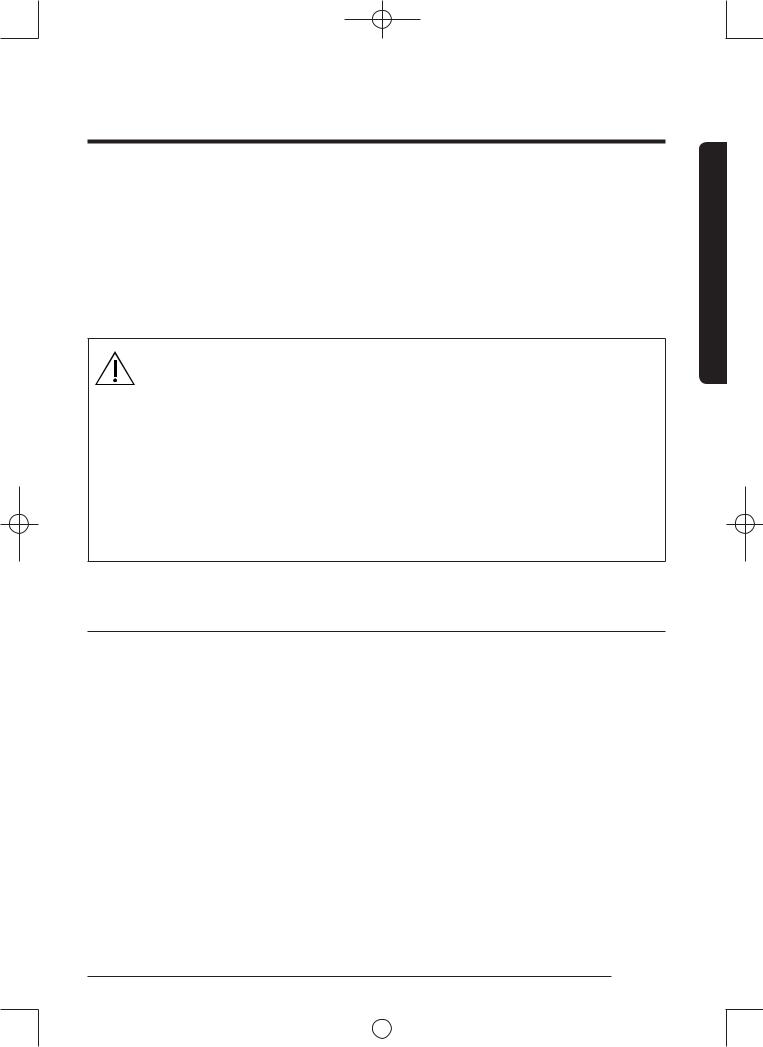
These warning signs are here to prevent injury to yourself and others. Please follow them explicitly.
After reading this manual, store it in a safe place for future reference.
Read all instructions before using the appliance.
As with any equipment that uses electricity and moving parts, potential hazards exist. To safely operate this appliance, familiarize yourself with its operation and exercise care when using it.
WARNING - Risk of Fire
ŷ Clothes dryer installation must be performed by a qualified installer.
ŷ Install the clothes dryer according to the manufacturer’s instructions and local codes. ŷ Do not install a clothes dryer with flexible plastic venting materials. If flexible metal (foil type) duct is installed, it must be of a specific type identified by the appliance manufacturer as suitable for use with clothes dryers. Flexible venting materials are known to collapse, be easily crushed, and trap lint. These conditions will obstruct
clothes dryer airflow and increase the risk of fire.
ŷ To reduce the risk of severe injury or death, follow all installation instructions. ŷ Save these instructions.
information Safety
Important safety precautions
 WARNING
WARNING
To reduce the risk of fire, electric shock, or injury to persons when using your appliance, follow basic precautions, including the following:
1.Read all instructions before using this appliance.
2.Do not dry articles that have been previously cleaned in, washed in, soaked in, or spotted with gasoline, dry-cleaning solvents, or other flammable or explosive substances, as they give off vapors that could ignite or explode.
3.Do not use the dryer to dry clothes which have traces of any flammable substance, such as vegetable oil, cooking oil, machine oil, flammable chemicals, paint thinner, etc., or anything containing wax or chemicals, such as mops and cleaning cloths. Flammable substances may cause the fabric to catch fire by itself.
SAVE THESE INSTRUCTIONS
English 5
|
|
|
|
DV7700J-03170Q-00_EN-US.indd 5 |
2015/1/31 9:17:42 |
||
|
|
|
|

Safety information
information |
4. Do not store or use gasoline or other flammable vapors and liquids near this or any other |
|
appliance. |
||
|
||
|
5. Do not allow children to play on or in the appliance. Close supervision of children is |
|
|
necessary when the appliance is used near children. |
|
Safety |
6. Before the appliance is removed from service or discarded, remove the door to the |
|
7. Do not reach into the appliance if the drum is moving. |
||
|
drying compartment. |
|
|
8. Do not install or store this appliance where it will be exposed to the weather. |
|
|
9. Do not tamper with internal controls. |
|
|
10. Do not repair or replace any part of the appliance or attempt any service unless |
|
|
specifically recommended in the user-maintenance instructions or in published userrepair |
|
|
instructions that you understand and have the skills to carry out. |
|
|
11. Do not use fabric softeners or products to eliminate static unless recommended by the |
|
|
manufacturer of the fabric softener or product. |
|
|
12. Clean the lint screen before or after each load. |
|
|
13. Do not use heat to dry articles containing foam rubber or similarly textured rubber-like |
|
|
materials. |
|
|
14. Keep area around the exhaust opening and adjacent surrounding areas free from the |
|
|
accumulation of lint, dust, and dirt. |
|
|
15. The interior of the appliance and exhaust duct should be cleaned periodically by qualified |
|
|
service personnel. |
|
|
16. Do not place items exposed to cooking oils in your dryer. Items contaminated with |
|
|
cooking oils may contribute to a chemical reaction that could cause a load to catch fire. |
|
|
17. This appliance must be grounded. See “Electrical requirements” and ”Grounding” in |
|
|
"Installation" section. |
|
|
18. Do not allow children to play on or in the appliance. Close supervision of children is |
|
|
necessary when the appliance is used near children. |
|
|
19. Do not insert your hand under the dryer. |
|
|
ŷ This may result in injury. |
|
|
20. Take care that children’s fingers are not caught in the door when closing it. |
|
|
ŷ This may result in injury. |
|
|
21. Control board and inlet valve are intentionally not grounded and may present a risk of |
|
|
electric shock only during servicing. |
|
|
ŷ Do not contact this part while appliance is energized. |
SAVE THESE INSTRUCTIONS
6 English
|
|
|
|
DV7700J-03170Q-00_EN-US.indd 6 |
2015/1/31 9:17:42 |
||
|
|
|
|
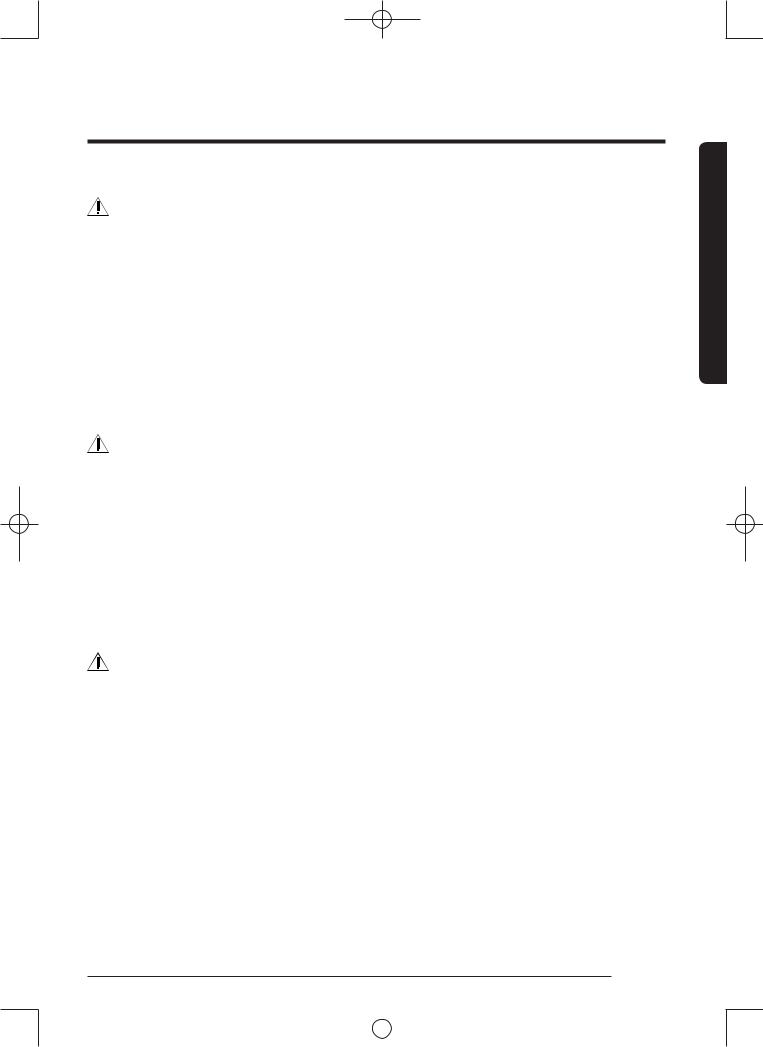
WARNING - To reduce the risk of fire or explosion:
ŷ Do not dry items that have been previously cleaned, washed, soaked, or spotted with gasoline, dry cleaning solvents, or other flammable or explosive substances. They emit vapors that could ignite or explode. Any material that has been in contact with a cleaning solvent or flammable liquids or solids should not be placed in the dryer until all traces of these flammable liquids or solids and their fumes have been removed.
There are many highly flammable items used in homes, such as acetone, denatured alcohol, gasoline, kerosene, some liquid household cleaners, some spot removers, turpentine, wpees, and wpe removers.
ŷ Items containing foam rubber (may be labeled latex foam) or similarly textured rubberlike materials must not be dried on a heat setting. Heated foam rubber materials can, under certain circumstances, produce fire by spontaneous combustion.
WARNING - What to do if you smell gas:
ŷ Do not try to light any appliance. ŷ Do not turn on the appliance.
ŷ Do not touch any electrical switch.
ŷ Do not use any phone in your building.
ŷ Clear the room, building or area of all occupants.
ŷ Immediately call your gas supplier from a neighbor’s phone. Follow the gas supplier’s instructions.
ŷ If you cannot reach your gas supplier, call the fire department.
ŷ Installation and service must be performed by a qualified installer, service agency, or the gas supplier.
WARNING - Gas Appliances:
This product contains chemicals known to the State of California to cause cancer and reproductive toxicity.
Gas appliances can cause low-level exposure to Proposition 65 listed substances, including but not limited to , benzene, carbon monoxide, formaldehyde and soot, substances resulting from the incomplete combustion of natural gas or LP fuels.
information Safety
SAVE THESE INSTRUCTIONS
English 7
|
|
|
|
DV7700J-03170Q-00_EN-US.indd 7 |
2015/1/31 9:17:42 |
||
|
|
|
|

Safety information
Safety information
Warnings
 WARNING
WARNING
Ensure pockets are free from small, irregularly shaped hard objects, foreign material, etc. ie. coins, knives, pins, etc. These objects could damage your dryer.
Gas leaks may occur in your system, resulting in a dangerous situation.
Cautions
 CAUTION
CAUTION
Do not allow children or pets to play on, in, or in front of the appliance. Close supervision is necessary when the appliance is used near children and pets.
Before discarding or removing your dryer from service, remove the door to the drying compartment to prevent children or animals from becoming trapped inside.
Do not reach into the appliance when the drum is moving.
Do not install or store this appliance where it will be exposed to the weather.
Do not tamper with controls.
Do not repair, replace, or attempt to service any part of the appliance unless specifically instructed to in the user-repair instructions and you have the understanding and skills to carry out the procedure.
Do not use fabric softeners or products to eliminate static unless the softener or product is recommended for dryer use by the manufacturer of the fabric softener or product.
Clean the lint screen before or after each load.
Keep the area around the exhaust opening and surrounding areas free from lint, dust, and dirt.
The interior of the dryer and exhaust duct should be cleaned periodically by qualified service personnel.
SAVE THESE INSTRUCTIONS
8 English
|
|
|
|
DV7700J-03170Q-00_EN-US.indd 8 |
2015/1/31 9:17:42 |
||
|
|
|
|

This appliance must be properly grounded. Never plug the power cord into a receptacle that is not grounded adequately or not in accordance with local and national codes. See installation instructions for information about grounding this appliance.
Do not sit on top of the dryer.
Do not wash clothing with large buckles, buttons, or other heavy metal or solid objects.
Gas leaks may not be detected by smell alone.
Gas suppliers recommend you purchase and install a UL-approved gas detector.
Install and use in accordance with the manufacturer’s instructions.
Do not place items in your dryer that have been spotted or soaked with vegetable oil or cooking oil. Even after being washed, these items may contain significant amounts of these oils.
Residual oil on clothing can ignite spontaneoulsy. The potential for spontaneous combustion increases when items containing vegetable oil or cooking oil are exposed to heat. Heat sources such as your dryer can warm these items, allowing an oxidation reaction in the oil to occur. Oxidation creates heat. If this heat cannot escape, the items can become hot enough to catch fire. Piling, stacking, or storing these kinds of items may prevent heat from escaping and can create a fire hazard.
All washed and unwashed fabrics that contain vegetable oil or cooking oil can be dangerous. Washing these items in hot water with extra detergent will reduce, but not eliminate, the hazard. Always use the Cool Down cycle for these items to reduce their temperature. Never remove these items from the dryer hot or interrupt the drying cycle until the items have run through the Cool Down cycle. Never pile or stack these items when they are hot..
information Safety
SAVE THESE INSTRUCTIONS
English 9
|
|
|
|
DV7700J-03170Q-00_EN-US.indd 9 |
2015/1/31 9:17:42 |
||
|
|
|
|
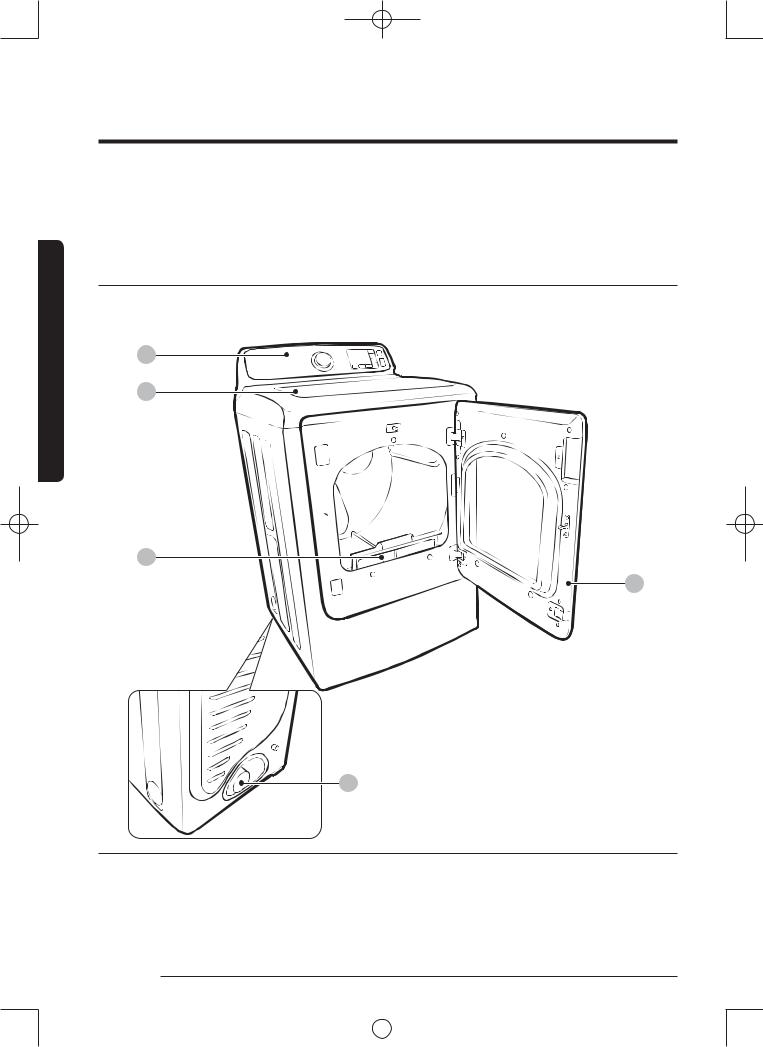
Installation
Installation
Follow these instructions carefully to ensure proper installation of the dryer and to prevent accidents when using it.
What’s included
Make sure all the parts are included in the product package. If you have a problem with the dryer or the parts, contact a local Samsung customer center or the retailer.
01
02
03
04
05
01 |
Control panel |
02 |
Work top |
03 Filter |
04 |
Door |
05 |
Duct exhaust |
|
10 English
|
|
|
|
DV7700J-03170Q-00_EN-US.indd 10 |
2015/1/31 9:17:43 |
||
|
|
|
|
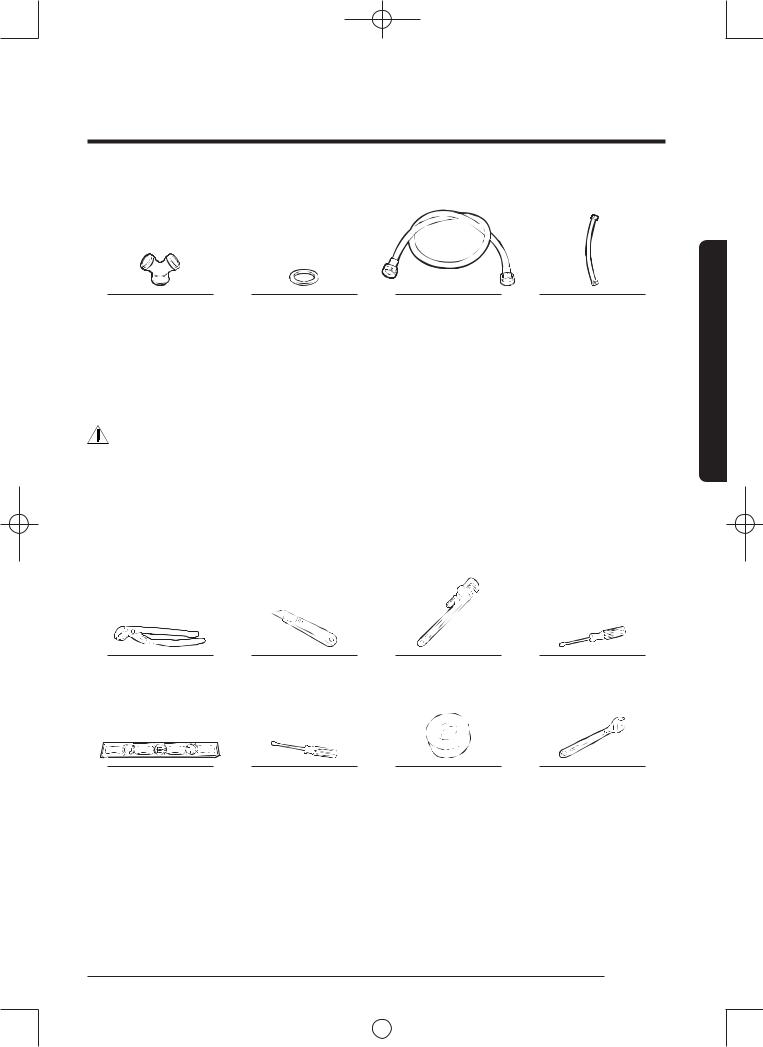
Y-connector |
Rubber washer |
Water hose |
Short water hose |
|
|
(for some models) |
|
 WARNING
WARNING
Packing materials can be dangerous to children. Keep all packing material (plastic bags, polystyrene, etc.) well out of children’s reach.
CAUTION
ŷ Do not move the product while holding the front part of the top cover of the dryer. This may cause the cover to separate from the dryer and result in injury.
ŷ Wear protective gloves whenever lifting or carrying the dryer to prevent personal injury or strain.
Tools needed for installation
Installation
Pliers |
Cutting knife |
Pipe wrench (for gas |
Nut drivers |
|
|
model only) |
|
Leveller |
Phillips screwdriver |
Duct tape |
Wrench |
English 11
|
|
|
|
DV7700J-03170Q-00_EN-US.indd 11 |
2015/1/31 9:17:44 |
||
|
|
|
|

Installation
Installation
Before installation
Please read the following instructions carefully before installing the dryer. These instructions should be kept for future reference.
 WARNING
WARNING
Remove the door from all discarded appliances to avoid the danger of a child suffocating. Control board and inlet valve are intentionally not grounded and may present a risk of electric shock only during servicing.
Service personnel - Do not contact this part while appliance is energized.
Basic requirements
Make sure you have everything necessary for proper installation
ŷ A GROUNDED ELECTRICAL OUTLET is required. See Electrical Requirements. ŷ A POWER CORD for electric dryers (except in Canada).
ŷ GAS LINES (if installing a gas dryer). The gas lines must meet national and local codes. ŷ EXHAUST SYSTEM - must be rigid metal or flexible stiff-walled metal exhaust ducting.
12 English
|
|
|
|
DV7700J-03170Q-00_EN-US.indd 12 |
2015/1/31 9:17:44 |
||
|
|
|
|

Location considerations
Locate the dryer where there is enough space at the front for loading the dryer, and enough space behind for the exhaust system. This dryer is factory-ready for rear exhaust. To exhaust out the bottom or the right or the left (electric model only), use the accessory exhaust kit (sold separately). Instructions are included with the kit. It’s important to make sure the room has enough fresh air. The dryer must be located where there is no air-flow obstruction.
On gas dryers, adequate clearance as noted on the data plate must be maintained to ensure adequate air for combustion and proper dryer operation.
Do not install or store the dryer in an area where it will be exposed to water and/or weather. Keep the dryer area clear of combustible materials, gasoline, and other flammable vapors and liquids. A dryer produces combustible lint. The area around the dryer should be kept lint free.
Alcove or closet installation
Minimum clearances between the dryer and adjacent walls or other surfaces are: 2” in front, 17” on top, 1” on either side, and 5” in the back.
The closet front must have two unobstructed air openings for a combined minimum total area of 72 in² with 3” minimum clearance on the top and bottom. A louvered door with equivalent space clearance is acceptable.
WARNING
ŷ You must exhaust the dryer to the outside to reduce the risk of fire when you install the dryer in and alcove or closet.
ŷ To reduce the risk of fire, you must exhaust the dryer to the outdoors. See "Exhausting" section.
ŷ No other fuel-burning appliance should be installed in the same closet as the dryer.
Installation
English 13
|
|
|
|
DV7700J-03170Q-00_EN-US.indd 13 |
2015/1/31 9:17:44 |
||
|
|
|
|
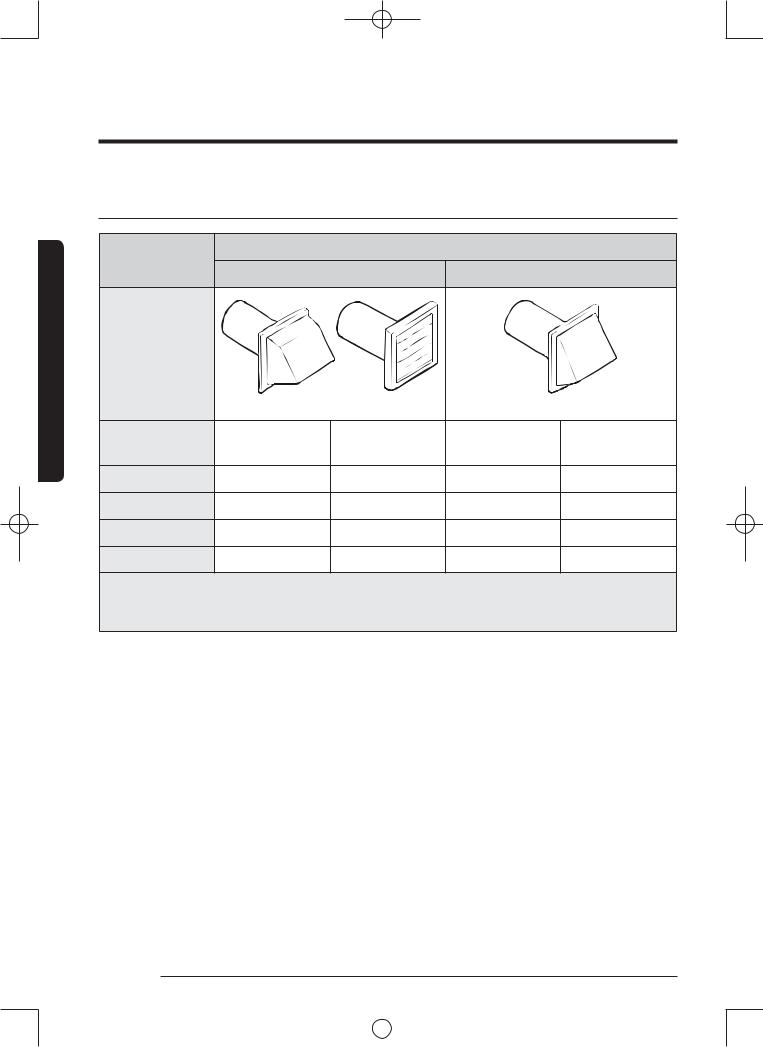
Installation
Ducting requirements
Weather hood type
|
Recommended |
Use only for short-run installation |
|||
Installation |
|
|
|
|
|
|
4” (10.2 cm) |
2.5” (6.4 cm) |
|||
No. of 90° |
Rigid |
Metallic |
Rigid |
Metallic |
|
elbows |
flexible* |
flexible* |
|||
|
|
||||
0 |
80 ft. (24.4 m) |
41 ft. (12.4 m) |
74 ft. (22.6 m) |
33 ft. (10.1 m) |
|
1 |
68 ft. (20.7 m) |
37 ft. (11.2 m) |
62 ft. (18.9 m) |
29 ft. (8.8 m) |
|
2 |
57 ft. (17.4 m) |
33 ft. (10.1 m) |
51 ft. (15.5 m) |
25 ft. (7.6 m) |
|
3 |
47 ft. (14.3 m) |
29 ft. (8.8 m) |
41 ft. (12.5 m) |
21 ft. (6.5 m) |
|
 NOTE
NOTE
* Do not use non-metallic flexible duct.
ŷ Use a 4-inch (10.2 cm) diameter rigid aluminum or rigid galvanized steel duct. ŷ Do not use a smaller duct.
ŷ Ducts larger than 4 inches (10.2 cm) in diameter can cause increased lint accumulation. Lint accumulation should be cleaned regularly.
ŷ If a flexible metal duct must be used, use the type with a stiff sheet metal wall. Do not use a flexible duct with a thin foil wall. Serious blockage can result if the flexible metal duct is bent too sharply.
ŷ Never install any type of flexible duct in walls, ceilings, or other concealed spaces. ŷ Keep the exhaust duct as straight and short as possible.
ŷ Secure joints with duct tape. Do not use screws.
ŷ Plastic flexible duct can kink, sag, be punctured, reduce airflow, extend drying times, and affect dryer operation.
ŷ Exhaust systems longer than recommended can extend drying times, affect machine operation, and may collect lint.
ŷ The exhaust duct should end with an exhaust hood with a swing-out damper to prevent back drafts and the entry of wildlife. Never use an exhaust hood with a magnetic damper.
14 English
|
|
|
|
DV7700J-03170Q-00_EN-US.indd 14 |
2015/1/31 9:17:44 |
||
|
|
|
|
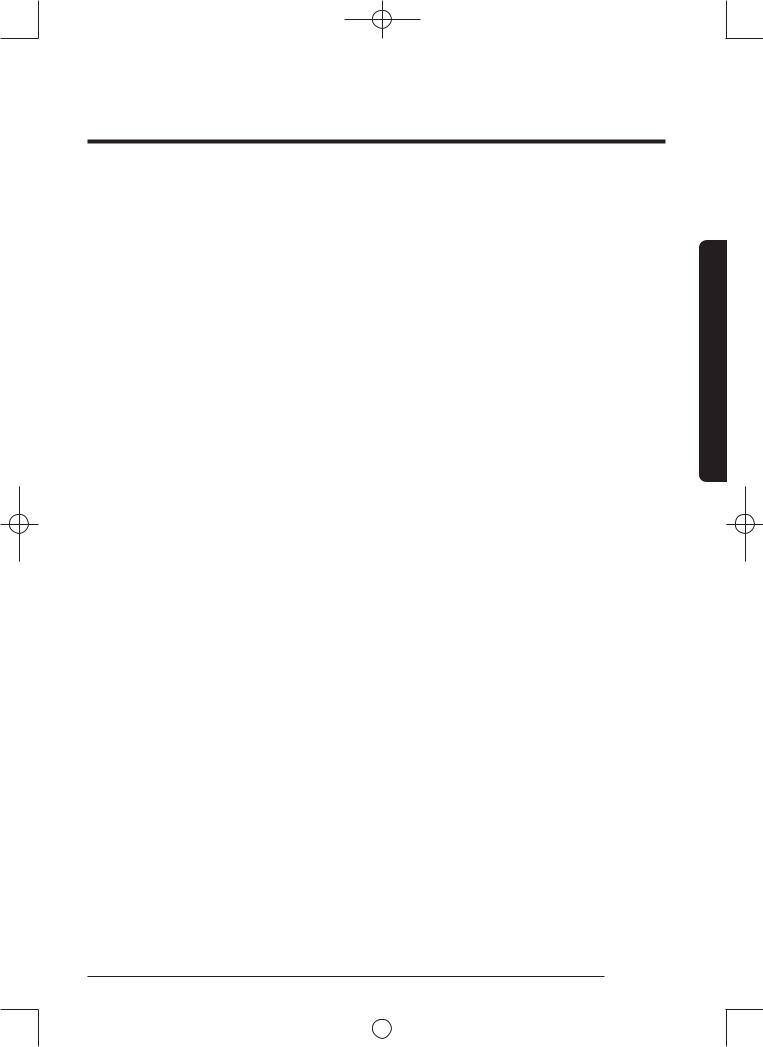
ŷ The hood should have at least 12 inches (30.5 cm) of clearance between the bottom of the hood and the ground or other obstruction. The hood opening should point down.
ŷ Never install a screen over the exhaust outlet.
ŷ To avoid lint buildup, do not exhaust the dryer directly into a window well. Do not exhaust under a house or porch.
ŷ If exhaust ductwork must run through an unheated area, the duct should be insulated and slope slightly down towards the exhaust hood to reduce condensation and lint buildup.
ŷ Inspect and clean the interior of the exhaust system at least once a year. Unplug the power cord before cleaning.
ŷ Check frequently to be sure the exhaust hood damper opens and closes freely.
ŷ Check once per month, and clean at least one time per year. Note: If clothes are not getting dry, then check ducting for obstructions.
ŷ Do not exhaust dryer into any wall, ceiling, crawl space, or concealed space of a building, gas vent, or any other common duct or chimney. This could create a fire hazard from lint expelled by the dryer.
If the new dryer is being installed into an existing exhaust system, you must make sure:
ŷ The exhaust system meets all local, state, and national codes. ŷ That a flexible plastic duct is not used.
ŷ To Inspect and clean all lint buildup from inside the existing duct. ŷ The duct is not kinked or crushed.
ŷ The exhaust hood damper opens and closes freely.
The static pressure in any exhaust system must not exceed 0.83 inches of water column, or be less than 0.
This can be measured with the dryer running with a manometer at the point where the exhaust duct connects to the dryer. A no-heat setting should be used. The dryer tumbler should be empty and the lint filter clean.
Installation
English 15
|
|
|
|
DV7700J-03170Q-00_EN-US.indd 15 |
2015/1/31 9:17:44 |
||
|
|
|
|
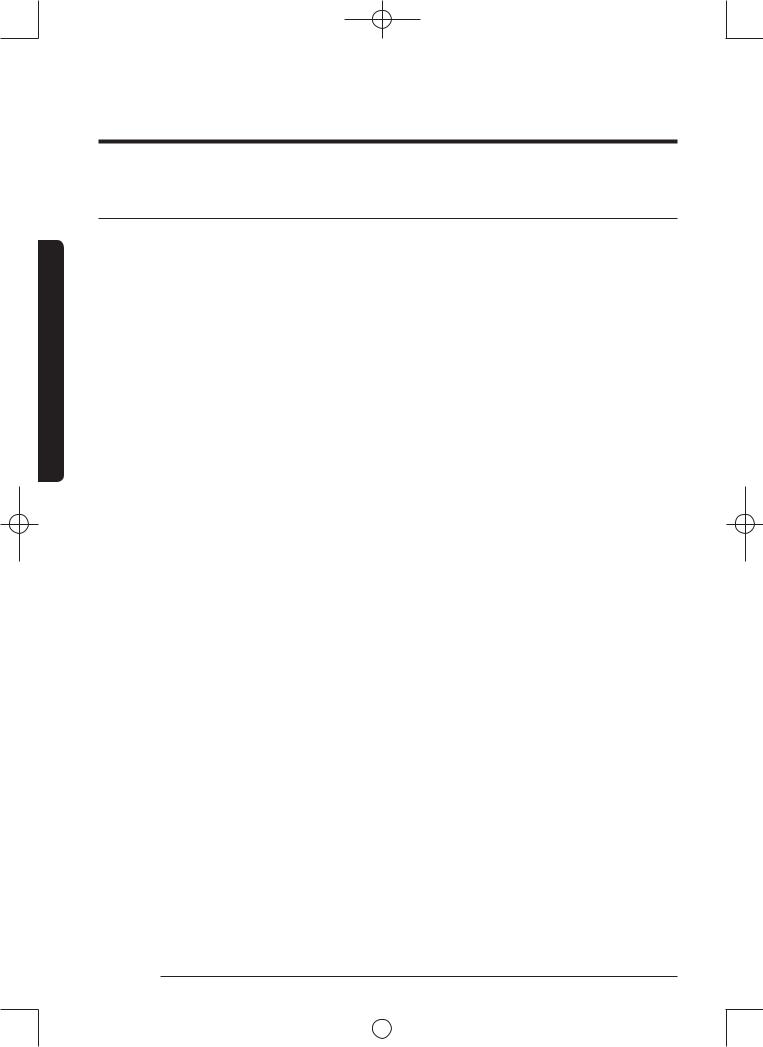
Installation
Installation
Exhausting
The dryer must not be exhausted into a chimney, a wall, a ceiling, an attic, a crawl space, or a concealed space of a building.
Exhausting the dryer to the outside will prevent large amount of lint and moisture from being blown into the room.
In the United States
ŷ All dryers must be exhausted to the outside.
ŷ The required exhaust duct is 4 inches (10.2 cm) in diameter.
ŷ Use only those foil-type flexible ducts, if any, specifically identified for use with the appliance by the manufacturer and that comply with the Outline for Clothes Dryer Transition Duct. Use Subject 2158A.
ŷ See “Ducting requirements” in the "Installation" section for the maximum duct length and number of bends that can be used.
ŷ The total length of flexible metal duct must not exceed 7' 10½" (2.4 m).
ŷ Do not assemble the duct with screws or other fasteners means that extend into the duct and catch lint
In Canada
ŷ All dryer must be exhausted to the outside.
ŷ The exhaust duct should be 4 inches (10.2 cm ) in diameter.
ŷ Use only those foil-type flexible ducts, if any, specifically indentified for use with the appliance by the manufacturer shall be used.
ŷ See “Ducting requirements” in the "Installation" section for the maximum duct length and number of bends.
ŷ The total length of flexible metal duct shall not exceed 7' 10½" (2.4 m).
ŷ Do not assemble the duct with screws or other fasteners means that extend into the duct and catch lint.
Outside the U.S. and Canada
ŷ Refer to the local codes.
 WARNING
WARNING
You must exhaust the dryer to the outside to reduce the risk of fire when you install the dryer in an alcove or closet.
NEVER USE A PLASTIC OR NON-METAL FLEXIBLE DUCT.
If your existing ductwork is plastic, non-metal, or combustible, replace it with metal.
Use only a metal exhaust duct that is non-flammable to ensure containment of exhaust air, heat, and lint.
16 English
|
|
|
|
DV7700J-03170Q-00_EN-US.indd 16 |
2015/1/31 9:17:44 |
||
|
|
|
|

Gas requirements
WARNING
ŷ Use only natural or LP (liquid propane) gases.
ŷ THE INSTALLATION MUST CONFORM WITH LOCAL CODES, OR IN THE ABSENCE OF LOCAL CODES, WITH THE NATIONAL FUEL GAS CODE ANSI/Z223.1, LATEST REVISION (FOR THE UNITED STATES), OR WITH THE CAN /CGA-B149 INSTALLATION CODES (FOR CANADA).
ŷ Gas dryers are equipped with a burner vent for use with natural gas. If you plan to use your dryer with LP (liquid propane) gas, it must be converted for safe and proper performance by a qualified service technician.
ŷ A 1/2” (1.27 cm) gas supply line is recommended and must be reduced to connect to the 3/8” (1 cm) gas line on your dryer. The National Fuel Gas Code requires that an accessible, approved manual gas shut-off valve be installed within 6” of your dryer.
ŷ Gas dryers installed in residential garages must be raised 18 inches (46 cm) above the floor.
Additionally, a 1/8” (0.3 cm) N.P.T. (National Pipe Thread) plugged tapping, accessible for test gauge connection, must be installed immediately upstream of your dryer’s gas supply connection.
ŷ Your dryer must be disconnected from the gas supply pipe system during any pressure testing of the system.
ŷ DO NOT reuse old flexible metal gas lines. Flexible gas lines must be design certified by the American Gas Association (CGA in Canada).
NOTE
ŷ Any pipe joint compound used must be resistant to the action of any liquefied petroleum gas.
ŷ As a courtesy, most local gas utilities will Inspect a gas appliance installation.
 NOTE
NOTE
GAS IGNITION: Your dryer uses an automatic ignition system to ignite the burner. There is no constant burning pilot.
Installation
English 17
|
|
|
|
DV7700J-03170Q-00_EN-US.indd 17 |
2015/1/31 9:17:45 |
||
|
|
|
|
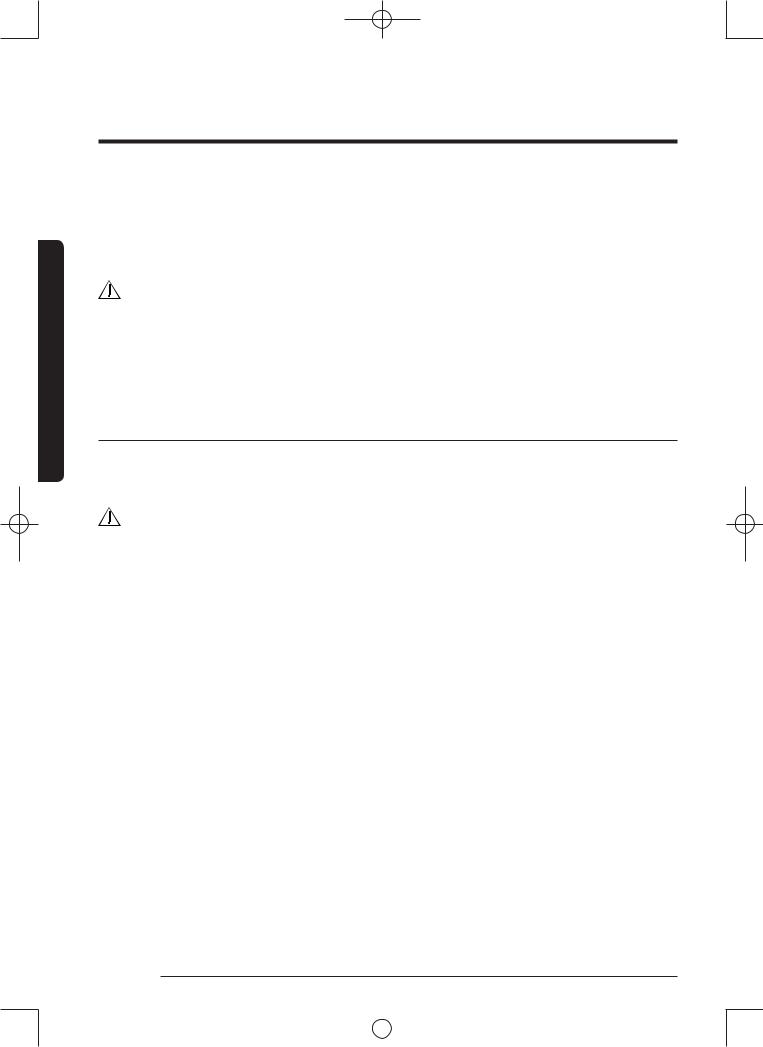
Installation
Installation
Commonwealth of Massachusetts installation instructions
Your dryer must be installed by a licensed plumber or gas fitter. A “T” handle manual gas valve must be installed in the gas supply line to your dryer. If a flexible gas connector is used to install your dryer, the connector can be no longer than 3’ (36”).
WARNING
ŷ Gas leaks may occur in your system, creating a dangerous situation. ŷ Gas leaks may not be detected by smell alone.
ŷ Gas suppliers recommend you purchase and install a UL-approved gas detector. ŷ Install and use in accordance with the manufacturer’s instructions.
Electrical requirements
 NOTE
NOTE
The wiring diagram is located on the plate below the control panel or frame back.
WARNING
ŷ Improperly connecting the equipment grounding conductor can result in a risk of electric shock.
Check with a qualified electrician or serviceman if you are in doubt as to whether your dryer is properly grounded. Do not modify the plug provided with your dryer – if it doesn’t fit the outlet, have a proper outlet installed by a qualified electrician.
ŷ To prevent unnecessary risk of fire, electrical shock, or personal injury, all wiring and grounding must be done in accordance with local codes, or in the absence of local codes, with the National Electrical Code, ANSI/NFPA No. 70-Latest Revision (for the U.S.) or the Canadian Electrical Code CSA C22.1 – Latest Revisions and local codes and ordinances. It is your responsibility to provide adequate electrical services for your dryer.
ŷ All gas installations must be done in accordance with the national Fuel Code ANSI/Z2231
– Latest Revision (for the U.S.) or CAN/CGA – B149 Installation Codes – Latest Revision (for Canada) and local codes and ordinances.
18 English
|
|
|
|
DV7700J-03170Q-00_EN-US.indd 18 |
2015/1/31 9:17:45 |
||
|
|
|
|
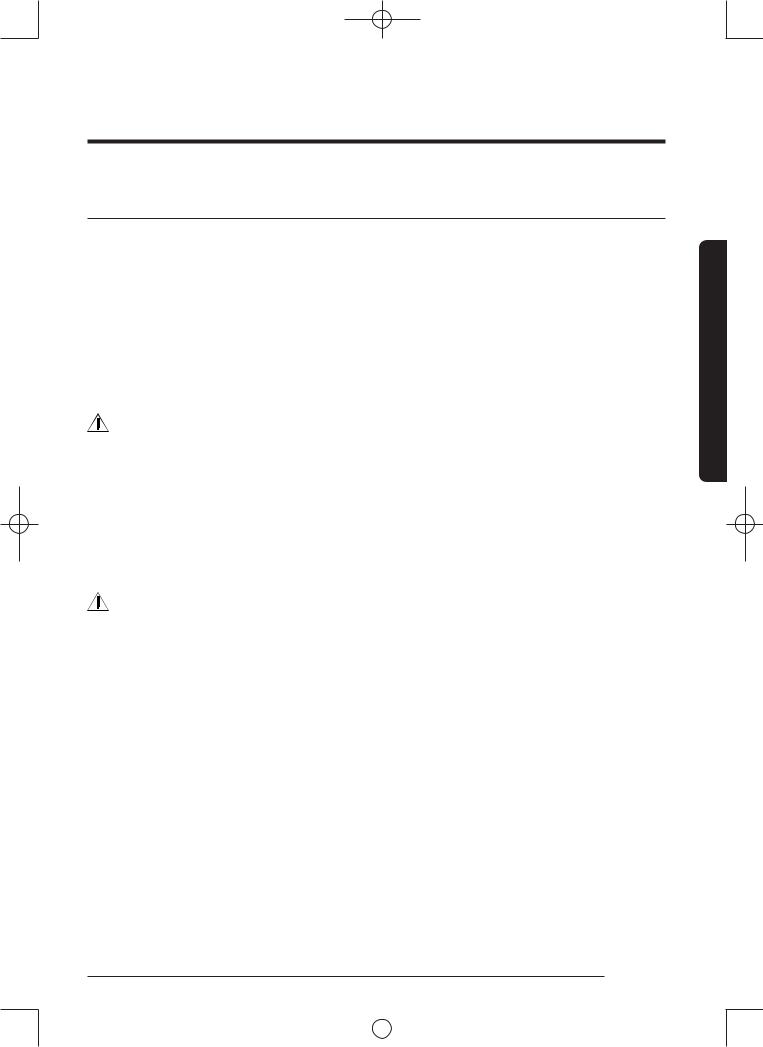
Grounding
This dryer must be grounded. In the event of malfunction or breakdown, the ground will reduce the risk of electrical shock by providing a path of least resistance for the electrical current.
 WARNING
WARNING
Improper connection of the equipment-grounding conductor can result in a risk of electric shock. Check with a qualified electrician or service representative or personnel if you are in doubt as to whether the appliance is properly grounded.
Gas models
WARNING
ŷ Your dryer has a cord with an equipment-grounding conductor and a grounding plug. The plug must be plugged into an appropriate outlet that is properly installed and grounded in accordance with all local codes and ordinances.
ŷ Do not modify the plug provided with your dryer – if it doesn’t fit the outlet, have a proper outlet installed by a qualified electrician.
ŷ Never connect the ground wire to plastic plumbing lines, gas lines, or hot water pipes.
Electric models
WARNING
ŷ Your dryer has an optional cord with an equipment-grounding conductor and a grounding plug.
This cord is sold separately.
ŷ The plug must be plugged into an appropriate outlet that is properly installed and grounded in accordance with all local codes and ordinances.
ŷ Do not modify the plug provided with your dryer – if it doesn’t fit the outlet, have a proper outlet installed by a qualified electrician.
ŷ If a power cord is not used and the electric dryer is to be permanently wired, the dryer must be connected to a permanently grounded metal wiring system, or an equipment grounding conductor must be run with the circuit conductors and connected to the equipment grounding terminal or lead on the dryer.
Installation
English 19
|
|
|
|
DV7700J-03170Q-00_EN-US.indd 19 |
2015/1/31 9:17:45 |
||
|
|
|
|
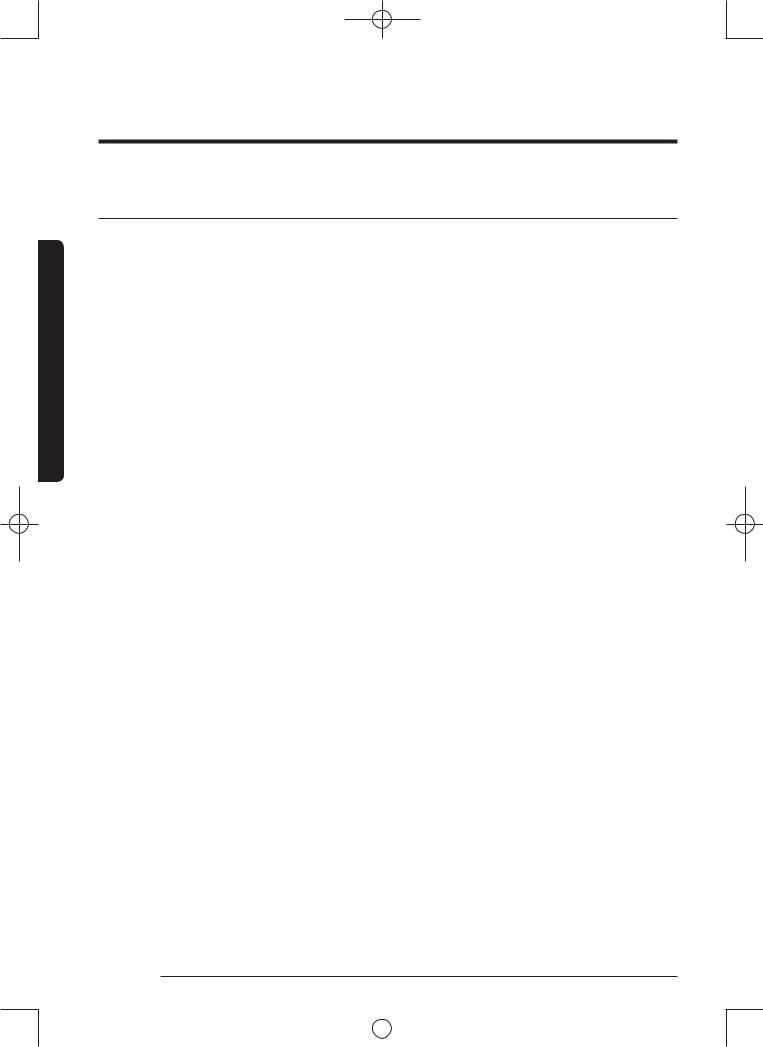
Installation
Installation
Electrical connections
Before operating or testing, follow all grounding instructions in the "Grounding" section. An individual branch (or separate) circuit serving only your dryer is recommended. DO NOT USE AN EXTENSION CORD.
Gas models – U.S. and Canada
A 120 volt, 60 Hz AC approved electrical service, with a 15-ampere fuse or circuit breaker is required.
Electric models – U.S. only
Most U.S. dryers require a 120 / 240 volt, 60 Hz AC approved electrical service. Some require 120 / 208 volt, 60 Hz approved electrical service. The electric service requirements can be found on the data label located behind the door. A 30-ampere fuse or circuit breaker on both sides of the line is required.
ŷ If a power cord is used, the cord should be plugged into a 30-ampere receptacle. ŷ The power cord is NOT provided with U.S. electric model dryers.
 WARNING
WARNING
Risk of Electric Shock
When local codes allow, the dryer electrical supply may be connected by means of a new power supply cord kit, marked for use with a dryer, that is U.L. listed and rated at a minimum of 120/240 volts, 30-ampere with three No. 10 copper wire conductors terminated with closed loop terminals, open-end spade lugs with turned up ends, or with tinned leads.
ŷ Do not reuse a power supply cord from an old dryer. The power cord electric supply wiring must be supported at the dryer cabinet by a suitable UL-listed strain relief.
ŷ Grounding through the neutral conductor is prohibited for (1) new branch-circuit installations, (2) mobile homes, (3) recreational vehicles, and (4) areas where local codes prohibit grounding through the neutral conductor. (Use a 4-prong plug for a 4 wire receptacle, NEMA type 14-30R.)
Electric models – Canada Only
ŷ A 120 / 240 volt, 60 Hz AC approved electrical service fused through a 30-ampere fuse or circuit breaker on both sides of the line is required.
ŷ All Canadian models are shipped with the power cord attached. The power cord should be plugged into a 30-ampere receptacle.
 NOTE
NOTE
It is not permissible to convert a dryer in Canada to 208 volts.
20 English
|
|
|
|
DV7700J-03170Q-00_EN-US.indd 20 |
2015/1/31 9:17:45 |
||
|
|
|
|

Step-by-step installation
For proper installation, we recommend that you hire a qualified installer.
Read these instructions completely before you begin the installation.
To install the dryer, follow these steps:
1.Move your dryer to an appropriate location for installation. Consider installing the dryer and washer sidebyside so you have easy access to both appliances.
 NOTE
NOTE
To move the dryer easily, lay two of the carton cushion-tops on the floor. Tip your dryer on its side so it lies across both cushion-tops. Push the dryer so that it is near its final location. Set your dryer upright.
Leave enough room around the dryer so you can attach the duct work, power cord, etc.
2.If you need to change the direction of the door, go to "Door reversal" on page 32. When done, return to Step 3 below.
3.Review the "Exhausting" section before installing the exhaust system. Install the duct work from your dryer to the exhaust hood. The crimped end of the duct sections must point away from your dryer. DO NOT use sheet metal screws when assembling ducting. These joints should be taped. Never use plastic flexible exhaust material.
 NOTE
NOTE
A tip for tight installations: Attach a section of the exhaust system to your dryer before putting it in place. Use duct tape to secure this section to your dryer, but do not cover the ventilation slots at the back of the dryer cabinet.
4.If you have an electric model, skip to Step 6. If you have a gas model, go to the next step.
5.Review the "Gas requirements" section, then follow the lettered steps below.
A.Remove the pipe thread protective cap.
B.Apply pipe joint compound or about 1 1/2 wraps of Teflon tape over all threaded connections.
The pipe joint compound must be resistant to the action of any liquefied petroleum gas.
C.Connect the gas supply to your dryer. An additional fitting is required to connect the 3/4” (1.9 cm) female thread end of a flexible connector to the 3/8” (1 cm) male threaded end on the dryer.
D.Securely tighten the gas line fitting over the threads.
E.Turn on the gas supply. Check all gas connections for leaks using a soap solution. If bubbles appear, tighten the connections and recheck. DO NOT use an open flame to check for gas leaks.
F.Go to Step 6.
English 21
Installation
|
|
|
|
DV7700J-03170Q-00_EN-US.indd 21 |
2015/1/31 9:17:45 |
||
|
|
|
|
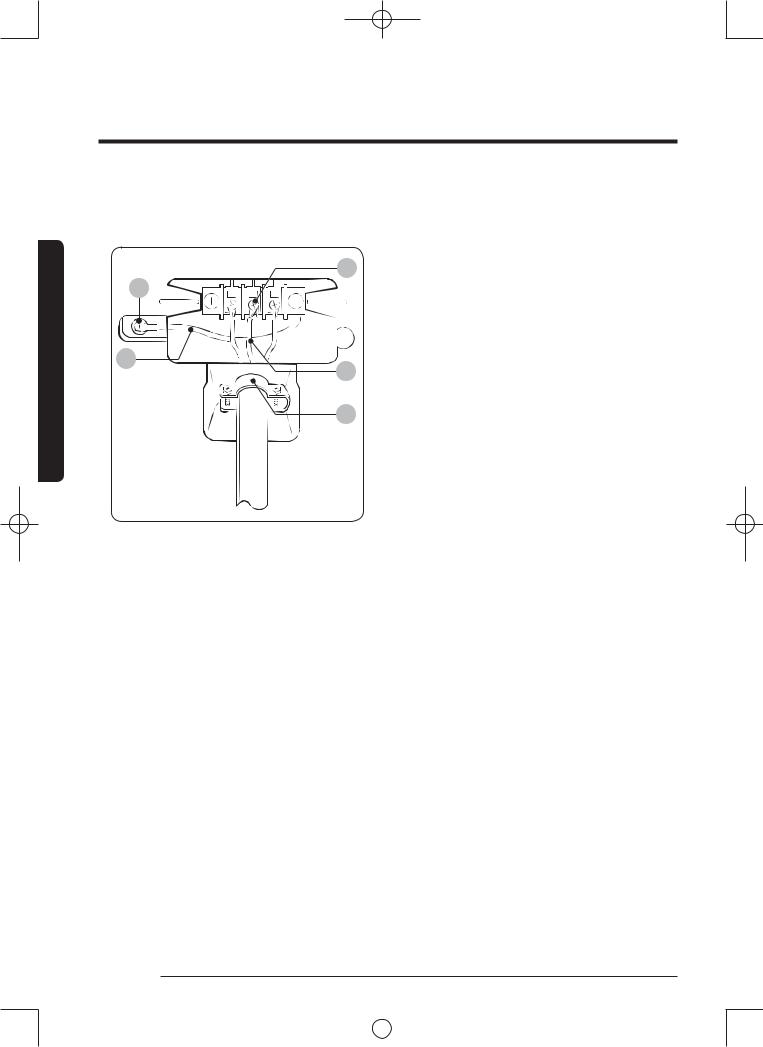
Installation
Installation
6.Review the "Electrical requirements" section, then follow the 3 Wire system connection instructions (Step 7) or 4 Wire system instructions (Step 8) below.
|
7. Three Wire system instructions: |
|
C |
A. |
External ground connector |
A |
B. |
Neutral grounding wire (white) |
|
C. Center silver-colored terminal block |
|
|
|
screw |
|
D. |
Neutral wire (white or center wire) |
B |
E. |
¾” (1.9 cm) UL-listed strain relief |
D |
|
a. Loosen or remove the center |
|
|
|
|
|
terminal block screw. |
E |
|
b. Connect the neutral wire (white |
|
|
or center wire) of the power |
|
|
cord to the center, silver-colored |
|
|
terminal screw of the terminal |
|
|
block. Tighten screw. |
|
|
c. Connect the other wires to outer |
|
|
terminal block screws. Tighten |
|
|
screws. |
|
|
d. Tighten the strain relief screws. |
|
|
e. Insert the tab of the terminal |
|
|
block cover into your dryer’s rear |
|
|
panel slot. |
|
|
Secure the cover with a hold- |
|
|
down screw. |
 WARNING
WARNING
If converting from a 4-wire electrical system to a 3-wire, you must connect the ground strap to the terminal block support to ground the dryer frame to the neutral conductor.
 NOTE
NOTE
We recommend using ring terminals. If you use strap terminals, please ensure you install them perfectly.
22 English
|
|
|
|
DV7700J-03170Q-00_EN-US.indd 22 |
2015/1/31 9:17:45 |
||
|
|
|
|

|
|
8. Four Wire System instructions: |
|
|
D |
A. |
External ground connector |
|
|
B. Green or bare copper wire of power |
|
|
A |
|
cord |
|
|
C. ¾” (1.9 cm) UL-listed strain relief |
|
|
|
D. Center silver-colored terminal block |
|
|
|
|
screw |
B |
E |
E. |
Neutral grounding wire (white) |
|
F. Neutral wire (white or center wire) |
||
|
|
||
F |
C |
|
a. Remove the External ground |
|
|
connector screw. |
|
|
|
|
b. Connect the ground wire (green |
|
|
|
or unwrapped) of the power cord |
|
|
|
to the external ground connector |
|
|
|
screw. If you want to connect |
|
|
|
B (Green or bare copper wire |
|
|
|
of power cord) to the Neutral |
|
|
|
Post without connecting it to A |
|
|
|
(cabinet ground), call a service |
|
|
|
technician. |
|
|
|
c. Loosen or remove the center |
|
|
|
terminal block screw. |
|
|
|
d. Connect the neutral wire (white |
|
|
|
or center wire) of the power cord |
|
|
|
and the appliance ground wire |
|
|
|
(white) under the central screw |
|
|
|
of the terminal block. |
|
|
|
e. Connect the other wires to the |
|
|
|
outer terminal block screws. |
|
|
|
Tighten screws. |
|
|
|
f. Tighten the strain relief screws. |
|
|
|
g. Insert the tab of the terminal |
|
|
|
block cover into your dryer’s rear |
|
|
|
panel slot. |
|
|
|
Secure the cover with a hold- |
|
|
|
down screw. |
 NOTE
NOTE
We recommend using ring terminals. If you use strap terminals, please ensure you install them perfectly.
English 23
Installation
|
|
|
|
DV7700J-03170Q-00_EN-US.indd 23 |
2015/1/31 9:17:46 |
||
|
|
|
|

Installation
Installation
WARNING
For U.S. models: Risk of electrical shock
ŷ All U.S.models are designed for a 3-WIRE SYSTEM CONNECTION. The dryer frame is grounded to the neutral conductor at the terminal block. A 4-WIRE SYSTEM CONNECTION is required for new or remodeled construction, mobile homes, or if local codes do not permit grounding through neutral. If you use the 4-wire system, you cannot ground the dryer frame to the neutral conductor at the terminal block.
ŷ Remove the terminal block cover plate. Insert the power cord with a UL-listed strain relief through the hole provided in the cabinet near the terminal block.
ŷ A strain relief must be used. Do not loosen the nuts already installed on the terminal block. Be sure they are tight. Use a 3/8” (1cm) deep well socket.
|
9. To ensure that the dryer provides |
|
optimal drying performance, it must |
A |
be level. To level the dryer, follow the |
|
lettered steps below: |
|
A. Using a leveller (A), check if the |
|
dryer is level side to side and then |
|
front to back. |
|
B. If the dryer is not level, adjust the |
|
leveling feet (B) on the bottom of the |
|
dryer until the dryer is level side to |
|
side and back to front. |
|
Turning the feet clockwise retracts |
|
the feet. Turning the feet clockwise |
|
loosens and extends them. |
B |
24 English
|
|
|
|
DV7700J-03170Q-00_EN-US.indd 24 |
2015/1/31 9:17:46 |
||
|
|
|
|

|
|
NOTE |
|
|
|
If you have a dryer and dryer: |
|
|
|
ŷ To set the dryer to the same height as |
|
|
|
the washer, fully retract (A) the leveling |
|
|
|
feet by turning them counterclockwise, |
|
A |
B |
then loosen (B) the feet by turning |
|
them clockwise. Once the dryer is the |
|||
|
|
||
|
|
same height as the washer, follow the |
|
|
|
directions above to level the dryer. |
|
|
|
ŷ Adjust the leveling feet only as much as |
|
|
|
necessary to level the dryer. Extending |
|
|
|
the leveling feet more than necessary |
|
|
|
can cause the dryer to vibrate. |
10.Make sure all gas connections (on gas models) and exhaust, and electrical connections are complete.
Plug in your dryer, and then check its operation by using the checklist on page 28.
11.For GAS MODELS ONLY: The burner may not ignite initially due to air in the gas line. Allowing your dryer to operate on a heat setting will purge the line. If the gas does not ignite within 5 minutes, turn your dryer off and wait 5 minutes. Be sure the gas supply to your dryer has been turned on. To confirm gas ignition, check the exhaust for heat.
English 25
Installation
|
|
|
|
DV7700J-03170Q-00_EN-US.indd 25 |
2015/1/31 9:17:46 |
||
|
|
|
|

Installation
Connecting the inlet hose
Installation
26 English
Method1
The dryer must be connected to the cold water faucet using the new inlet hoses. Do not use old hoses.
1.If space permits, attach the brass female end of the “Y” connector to the cold water faucet.
2.Turn the cold water faucet off.
3.Attach the straight end of the long hose to the “Y’ connector.
4.Using pliers, tighten the coupling with an additional two-thirds turn.
 NOTE
NOTE
Do not overtighten, as it may damage the coupling.
5.Attach the angled end of the long hoses to the fill valve at the bottom of the dryer’s rear frame. Screw on the
coupling by hand until it is seated on the fill valve connector.
6.Using pliers, tighten the coupling with an additional two-thirds turn.
 NOTE
NOTE
Do not overtighten, as it may damage the coupling.
7.Turn the cold water faucet on.
8.Check for leaks around the “Y” connector, faucets, and hoses.
|
|
|
|
DV7700J-03170Q-00_EN-US.indd 26 |
2015/1/31 9:17:47 |
||
|
|
|
|

|
|
Method2 |
|
|
|
The dryer must be connected to the cold |
|
|
|
water faucet using the new inlet hoses. Do |
|
|
|
not use old hoses. |
|
|
|
1. |
If the “Y” connector (A) cannot be |
|
|
|
attached directly to the cold water |
|
|
|
faucet, the short hose must be used. |
|
|
2. |
Turn the cold water faucet off. |
|
B |
3. |
Attach the short inlet hose (B) to the cold |
|
|||
|
|
|
water faucet. |
|
|
|
Screw on the coupling by hand until it is |
|
|
|
seated on the faucet. |
|
|
4. |
Using pliers, tighten the coupling with |
|
|
|
an additional two-thirds turn. |
 NOTE
NOTE
A
Do not overtighten, as it may damage the coupling.
C
English 27
Installation
|
|
|
|
DV7700J-03170Q-00_EN-US.indd 27 |
2015/1/31 9:17:47 |
||
|
|
|
|
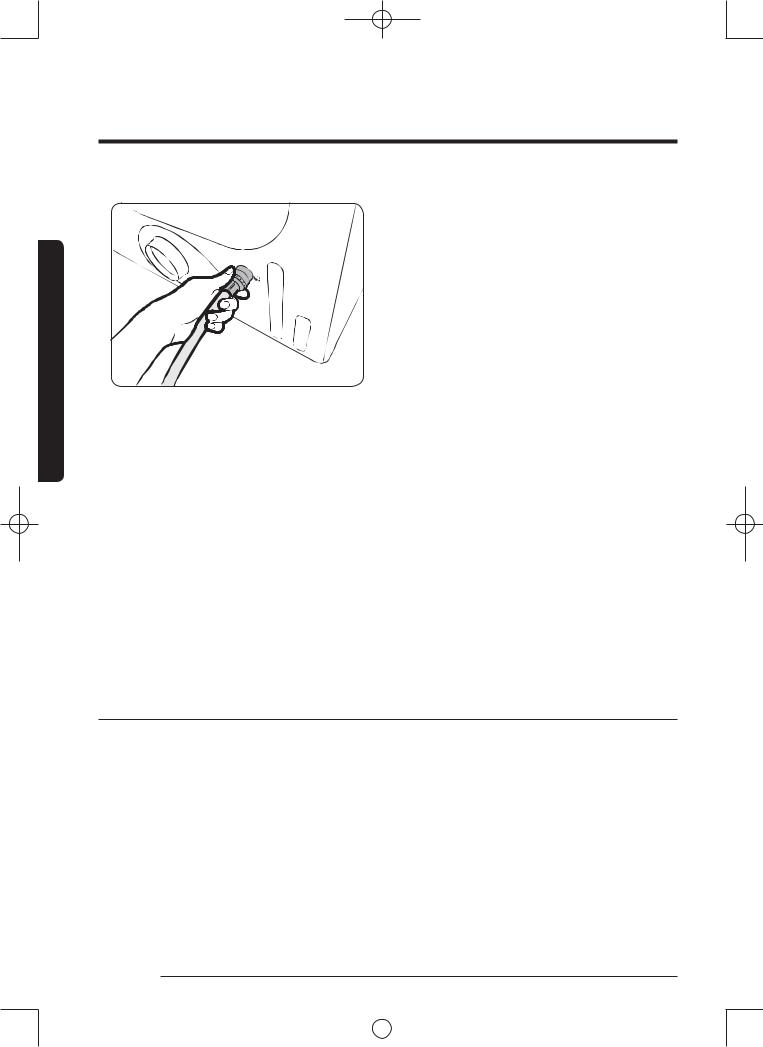
Installation
Installation
5.Attach the ‘Y” connector to the brass male end of the small hose.
Screw on the coupling by hand until it is seated on the connector.
6.Using pliers, tighten the coupling with an additional two-thirds turn.
 NOTE
NOTE
Do not overtighten, as it may damage the coupling.
7.Attach the angled end of water hoses
(C) to the fill valve at the bottom of the dryer rear frame. Screw on the coupling by hand until it is seated on the fill valve connector.
8.Using pliers, tighten the coupling with an additional two-thirds turn.
 NOTE
NOTE
Do not overtighten, as it may damage the coupling.
9.Turn the cold water faucet on.
10.Check for leaks around the “Y” connector, faucets and hoses.
Final installation check list
ŷ The dryer is plugged into an electrical outlet and grounded properly. ŷ The exhaust ductwork is hooked up and the joints are taped.
ŷ You have used rigid or stiff-walled flexible metal duct material, not plastic flexible duct.
ŷ The dryer is level and is sitting firmly on the floor.
ŷ For gas models: The gas is turned on and there are no gas leaks. ŷ Start your dryer to confirm that it runs, heats, and shuts off.
28 English
|
|
|
|
DV7700J-03170Q-00_EN-US.indd 28 |
2015/1/31 9:17:47 |
||
|
|
|
|

Vent blockage test (DV48J7700E(G)*)
After the dryer is installed, start the Test to check if the exhaust system is applicable for the dryer. Vent Blockage Test detects duct state of the dryer automatically and report blockage state of the duct to the user. Proper duct state can help users to reduce drying time and save energy.
 NOTE
NOTE
Vent Blockage Test must run at cool state.
Operation method
1.Check if the drum is empty and close the door.
(If there is any clothes or other item in the drum, correct diagnosis can’t be made.)
2.Press the power button to turn the dryer on, then press and hold both the Adjust time Up and Dry level buttons simultaneously for 3 seconds.
When entering the Test mode, “InS” will appear in the display.
(If other procedure is started before entering the Test mode, it’s unable to enter the Test mode.)
3.Starting diagnosis immediately after pressing the Start button, During diagnosis, the operation state is displayed in the form of “000“.
Diagnosis time is about 2 minutes. Don’t open the door during diagnosis.
4.About 2min. Later, if the diagnosis is completed, diagnosis result is displayed and tone is given.
If state of the exhaust system is normal, “End” appears and completion sounds is given. If the exhaust system can’t exhaust smoothly, “CLg” appears and alarm sounds is given. In case of any other problem, information code appears; Check the information codes in this manual.
ŷ In order to stop or cancel the diagnosis mode, press the power button to turn off your dryer.
ŷ During diagnosis, if “C1” appears, check if the door is open.
ŷ The result displays about 5 min. and is off automatically 5 min. later. You may close it directly by pressing the power button (off).
 NOTE
NOTE
ŷ During or after diagnosis, the internal drum is hot; Be careful and don’t be scalded. Vent Blockage Test is used to check if there is some problem to the current exhaust system when the dryer is set for the first time.
ŷ If the diagnosis result displays “CLg” (the exhaust system is blocked ), refer to “DUCTING REQUIREMENTS” and “DRYER EXHAUST TIPS” section of this manual and take proper measures for drying.
English 29
Installation
|
|
|
|
DV7700J-03170Q-00_EN-US.indd 29 |
2015/1/31 9:17:47 |
||
|
|
|
|

Installation
Installation
ŷ If diagnosis is suspended, it could result in the wrong results. It must be tested according to diagnosis procedures.
ŷ Even if the diagnosis result is normal (“End”), the exhaust system may also be interrupted or blocked slightly. Set properly according to Installation process of this manual.
Dryer exhaust tips
 WARNING
WARNING
Plastic or non-metal flexible duct presents a potential fire hazard.
1. Make sure your dryer is installed properly so it exhausts air easily.
2. Use 4”(*) diameter rigid metal duct. Tape
* |
all joints, including at the dryer. |
|
Never use lint-trapping screws. |
||
|
||
|
|
30 English
|
|
|
|
DV7700J-03170Q-00_EN-US.indd 30 |
2015/1/31 9:17:48 |
||
|
|
|
|
